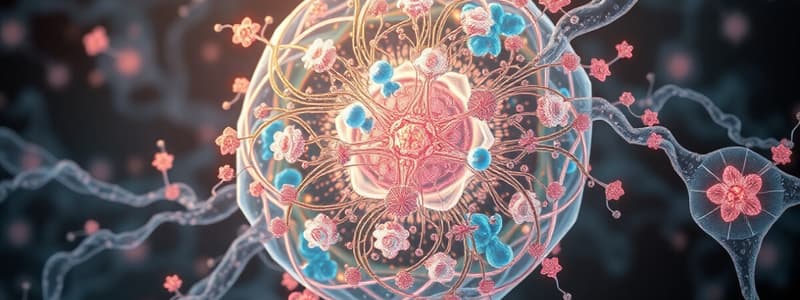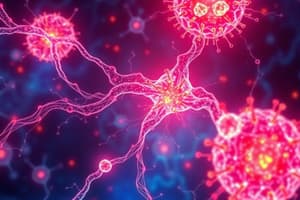Podcast
Questions and Answers
What allows signaling molecules to produce different effects in distinct types of cells?
What allows signaling molecules to produce different effects in distinct types of cells?
- Unique intracellular proteins in different cells (correct)
- The presence of the same receptor across all cell types
- Same number of ligand molecules produced
- The same intracellular signaling pathway in all cells
Which factor does NOT contribute to the integration of signaling pathways in a cell?
Which factor does NOT contribute to the integration of signaling pathways in a cell?
- The presence of multiple phosphorylation sites on proteins
- The cell's capacity to receive a single type of signal (correct)
- The total number of signaling molecules present
- The strength of connections among signaling molecules
Which description is associated with a fast response in signaling?
Which description is associated with a fast response in signaling?
- Activation of gene expression
- Production of new proteins
- Endocytosis of receptors
- Change in membrane potential (correct)
What is one effect of receptor down-regulation?
What is one effect of receptor down-regulation?
How does amplification occur in signaling cascades?
How does amplification occur in signaling cascades?
What is a consequence of prolonged ligand exposure in signaling?
What is a consequence of prolonged ligand exposure in signaling?
Which process is NOT a method of deactivating a signaling pathway?
Which process is NOT a method of deactivating a signaling pathway?
What role do signaling molecules play in the process of apoptosis when signals are absent?
What role do signaling molecules play in the process of apoptosis when signals are absent?
What role do second messengers play in signal transduction?
What role do second messengers play in signal transduction?
Which of the following accurately describes the function of phospholipases in cellular signaling?
Which of the following accurately describes the function of phospholipases in cellular signaling?
What is the primary function of G-protein-coupled receptors in signal transduction?
What is the primary function of G-protein-coupled receptors in signal transduction?
Which enzyme is responsible for converting ATP into cyclic AMP?
Which enzyme is responsible for converting ATP into cyclic AMP?
Which mechanism allows cells to modulate their response to stimuli after initial signaling?
Which mechanism allows cells to modulate their response to stimuli after initial signaling?
What type of proteins are small G proteins, and what is their role?
What type of proteins are small G proteins, and what is their role?
In signal transduction, how does amplification affect the strength of the signal?
In signal transduction, how does amplification affect the strength of the signal?
What type of receptors possess intrinsic or associated enzymatic activity?
What type of receptors possess intrinsic or associated enzymatic activity?
Which characteristic of cell signaling describes how well a receptor selectively binds to its ligand?
Which characteristic of cell signaling describes how well a receptor selectively binds to its ligand?
Pathway integration in cell signaling primarily involves which of the following?
Pathway integration in cell signaling primarily involves which of the following?
What is a key factor that affects the dynamics of cellular responses to signaling molecules?
What is a key factor that affects the dynamics of cellular responses to signaling molecules?
Which mechanism is responsible for the adaptation of a signaling pathway to prevent overstimulation?
Which mechanism is responsible for the adaptation of a signaling pathway to prevent overstimulation?
Which principle is crucial for optimizing cell signaling in response to varying external conditions?
Which principle is crucial for optimizing cell signaling in response to varying external conditions?
How does signal amplification play a role in cellular signaling cascades?
How does signal amplification play a role in cellular signaling cascades?
In cell signaling, what is the primary purpose of specificity at the molecular level?
In cell signaling, what is the primary purpose of specificity at the molecular level?
What effect does decreasing receptor sensitivity have on a cell's response to a signaling molecule?
What effect does decreasing receptor sensitivity have on a cell's response to a signaling molecule?
Flashcards
Specificity of Signaling
Specificity of Signaling
Signaling molecules bind to specific receptors on target cells, triggering different responses depending on the cell type.
Signal Pathway Integration
Signal Pathway Integration
Multiple signaling pathways interact to produce a coordinated cellular response.
Fast Cellular Response
Fast Cellular Response
Rapid changes in cell function achieved by modifying existing proteins or ion channel activity.
Slow Cellular Response
Slow Cellular Response
Signup and view all the flashcards
Signal Pathway Deactivation
Signal Pathway Deactivation
Signup and view all the flashcards
Signal Amplification
Signal Amplification
Signup and view all the flashcards
Cellular Apoptosis
Cellular Apoptosis
Signup and view all the flashcards
Multiple Phosphorylation Sites
Multiple Phosphorylation Sites
Signup and view all the flashcards
Ligands and Receptors
Ligands and Receptors
Signup and view all the flashcards
Types of Cell Surface Receptors
Types of Cell Surface Receptors
Signup and view all the flashcards
G-protein Coupled Receptors (GPCRs)
G-protein Coupled Receptors (GPCRs)
Signup and view all the flashcards
Enzyme-Coupled Receptors
Enzyme-Coupled Receptors
Signup and view all the flashcards
Kinases: Molecular Switches
Kinases: Molecular Switches
Signup and view all the flashcards
Second Messengers
Second Messengers
Signup and view all the flashcards
Signal Transduction: Relay
Signal Transduction: Relay
Signup and view all the flashcards
Signal Transduction Functions
Signal Transduction Functions
Signup and view all the flashcards
What are the 4 main types of cell signaling?
What are the 4 main types of cell signaling?
Signup and view all the flashcards
What are the 3 stages of cell signaling?
What are the 3 stages of cell signaling?
Signup and view all the flashcards
What is a ligand?
What is a ligand?
Signup and view all the flashcards
What are the types of signaling molecule receptors?
What are the types of signaling molecule receptors?
Signup and view all the flashcards
What are intracellular signaling proteins?
What are intracellular signaling proteins?
Signup and view all the flashcards
What are second messengers?
What are second messengers?
Signup and view all the flashcards
What are effector proteins?
What are effector proteins?
Signup and view all the flashcards
What is signal transduction?
What is signal transduction?
Signup and view all the flashcards
Study Notes
Cell Signaling I - Principles of Cell Signaling
- Lecture date: 11/4/2024
- Instructor: Tobias Weinrich, PhD
- Institution: The University of Texas Rio Grande Valley
Student Learning Outcomes
- Describe the main ways cells signal.
- Explain the three phases of a general signaling cascade.
- Identify and describe the different types of molecules involved in signaling pathways.
- Relate receptor location to the type of signaling molecule.
- Differentiate between specificity, amplification, adaptation, integration, and signal distribution steps in a signaling cascade.
- Explain different types of response times to extracellular ligands.
- Identify mechanisms for deactivating signaling pathways.
- Correctly interpret schematic representations of signaling cascades.
Lecture Structure
- Types of Cell Signaling
- Stages of Cell Signaling
- Types of signaling molecules
- Extracellular signaling molecule (ligand)
- Receptor proteins
- Intracellular signaling proteins (enzymes, molecular switches, second messengers)
- Effector proteins
- Signal transduction
Types of Cell Signaling
- Direct Cell-Cell Contact (Juxtacrine):
- Membrane-bound signaling molecule.
- Does not involve secreted molecules.
- Signaling by Secreted Molecules:
- Endocrine (long distance, bloodstream) - hormones
- Paracrine (neighboring cells) - local mediators
- Neuronal (synaptic) - neurotransmitters
- Autocrine (signaling cell is the target)
Stages of Cell Signaling
- Signal reception: ligand and receptor interaction
- Signal transduction: interpretation of the signal
- Cellular response: altered metabolism, altered cell shape, altered gene expression
Types of Molecules
- Ligand (primary messenger): extracellular signaling molecule
- Receptor protein: cell surface, intracellular
- Proteins (enzymes)
- Non-proteins (second messenger)
- Effector/target proteins (Metabolic Enzyme, Transcription Factor, Cytoskeletal Protein)
Signal Molecules (Primary Messengers)
- Extracellular signal molecules: hormones, photons, mechanical force, chemical odorants, membrane-bound signaling molecules, macromolecules (proteins, lipids, carbohydrates, nucleic acids), neurotransmitters
- Epinephrine, cortisol, estradiol, testosterone, thyroid hormone, insulin, epidermal growth factor (EGF), platelet-derived growth factor (PDGF), nerve growth factor (NGF), histamine, nitric oxide (NO), acetylcholine, etc.
Receptor Proteins
- Intracellular: hydrophobic ligands
- Enzyme (example: NO receptor, guanylyl cyclase)
- Transcription factors (nuclear receptors)
- Cell surface: hydrophilic ligands
- Ion channel-coupled receptors
- G-protein-coupled receptors
- Enzyme-coupled receptors
- Intrinsic enzymatic activity and associated enzymatic activity
Intracellular Signaling Molecules (Enzymes)
- Kinases (PKA, PKC, receptors, tyrosine, serine/threonine phosphatases)
- Monomeric G proteins (small G proteins, GTPases)
- Adenylyl cyclase (convert ATP to cyclic AMP, cAMP)
- Guanylyl cyclase (convert GTP to cyclic GMP, cGMP)
- Phospholipases (cleave phospholipids in the cell membrane)
- Proteases (precursor proteins to active proteins, example: pro-caspases to caspases)
Intracellular Signaling Molecules (Second Messengers)
- Small, non-protein, intracellular molecules
- Short half-life
- Relay and amplify first messenger (ligand) signal
- Pass info. to other signaling proteins (cyclic AMP, cAMP, DAG, IP3, Ca2+)
Signal Transduction
- Interaction of a receptor and ligand causing behavioral changes in the cell (or changes to gene expression).
- Relay, amplification, integration, distribution.
Specificity
- Signaling molecules bind receptors on target cells
- Same ligand can induce different responses in the target cell (based on receptor type).
- Different receptors lead to diverse responses.
Integration and Coordination
- Multiple signaling pathways in a cell interact to enable the cell to respond to a mixture of external signals.
- Responses depend on signaling molecule number and strength.
- In the absence of appropriate signals, the cell may die (apoptosis).
Dynamics - Speed
- Fast responses result from impacting existing proteins (activation/inhibition) and/or ion channel changes.
- Slow responses involve gene expression changes.
- Duration of ligand presence/exposure can affect cell behavior
Dynamics - Deactivation of Signaling Pathways
- Receptor sequestration (receptor endocytosis)
- Receptor down-regulation (receptor endocytosis and digestion)
- Receptor inactivation
- Phosphorylation of receptor
- Inactivation or proteolysis of signaling molecule
- Production of inhibitory protein
Dynamics - Sensitivity, Adaptation and Amplification
- Sensitivity: Receptors detect very small ligand amounts resulting in changes to cell behavior. This sensitivity is achieved by signal amplification.
- Adaptation: Signal pathways adapt to the ligand amount, letting the cell respond to minor changes in the ligand concentration.
Dynamics - Optimization
- Scaffold proteins: Organize the complex of signaling molecules.
- Membrane domains: Lipid rafts (specific lipid clusters)
- Phosphoinositides: Membrane domains containing these phospholipids anchor and recruit signaling molecules.
- Activated receptor: Recruitment of signaling proteins
Studying That Suits You
Use AI to generate personalized quizzes and flashcards to suit your learning preferences.




